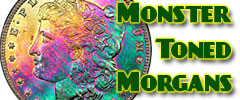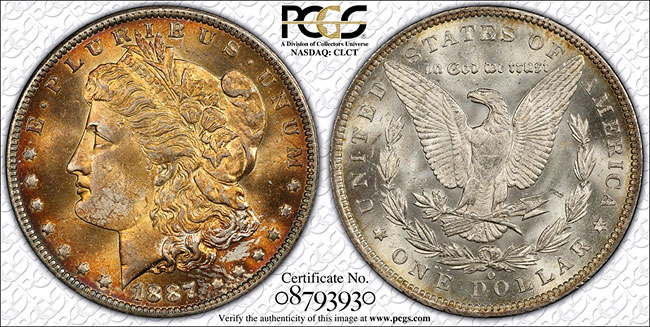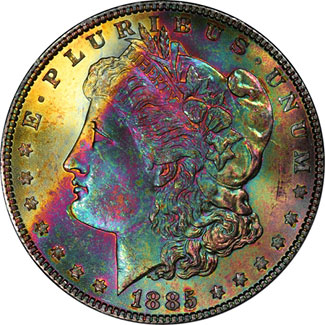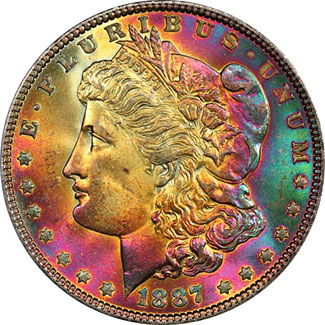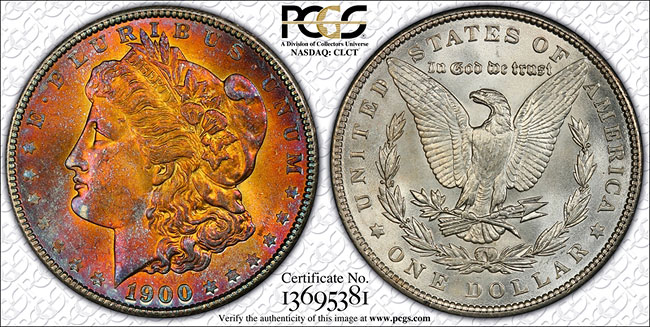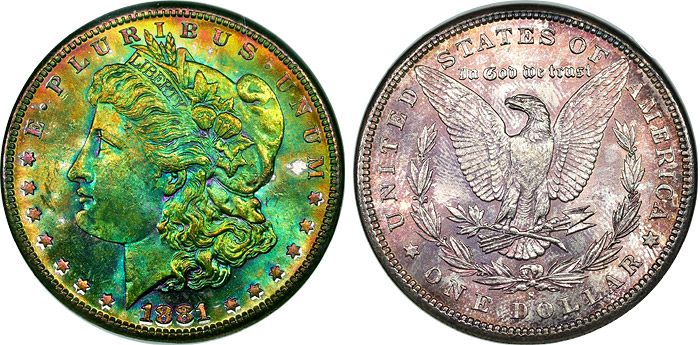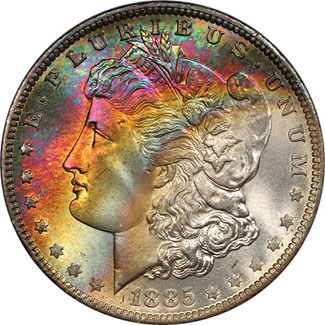









|

Need to contact us quickly? Send us an email by Clicking Here.
View the largest gallery of high-end and Monster rainbow toned Morgan dollars, an informational guide on how to tell natural vs. artificial toning, learn to price toned Morgans, view auction results of rainbow Morgans, and view what characteristics to look for in high-end toned rainbow Morgan dollars.
Lost? Find your way with the sitemap with links to all the pages on this website. Sitemap
Click here for a how-to guide for JhonECash.com. The site is very user friendly and you may not even need to use this page but if you do, it's right here waiting for you.
Click Here for answers to ALL of your questions regarding Payment, Shipping, How to Order, How to Use the Website, and More...
|
|
The first colors in the natural thin film
toning progression are various shades of gold. In my
classification system, I refer to them as light gold (class
A), medium gold (class B), and amber (class C) to russet
(class D). These are "first cycle" colors. Further along in
the progression, we return to some colors that are more
*yellow*. In my system, these include lemon yellow (class
I), sunset yellow (class J), to orange (class K); these are
"second cycle" colors. The point of the class designations
is to show you where these colors fall in the progression.
There is also a thrid cycle gold (class S) which is much
more rare, and has an altogether different appearance. Here are examples of first cycle gold colors, classes A & B (1895-O dollar), and class C (1887-O dollar):
Contrast the above with the more yellow second cycle colors (classes I, J) in these coins (I don't have any where it covers the entire coin, but it is theoretically possible, and much more likely on a smaller diameter coin):
This one ranges from sunset yellow through orange (class K) and beyond:
Here are two coins with a nice amount of the rare third cycle gold, which comes after emerald green in the progression. Finally, here are some banded rainbow toners that show the first cycle gold/amber (next to the untoned silver area) and second cycle yellows, in the context of a more complete spectrum of toning:
Anyway, I hope this helps to show the different kinds of golds and yellows that are possible with natural (or artificial) toning. The natural toning will always show some gradations in color, even if subtle. Arguments and Rebuttals:
<<That 1st coin appears to have the
classic dip stain toning. Just not fully rinsed after it was
dipped. But still attractive, probably took many years to
get that way.
Sorry but you are completely mistaken. The gem 1895-O dollar
is pedigreed to the Norweb collection and appears never to
have been dipped (unlike some of the other Norweb coins,
such as the 1893-S, which sadly suffered a different fate
after the Norwebs sold it). Dip stain toning tends to be
streaky, as one would expect from a liquid residue pattern,
very different from the radially symmetric target
distribution of the toning on this 1895-O (i.e. the toning
clings concentrically to the perimeter). This coin has a
pedigree back to 1908, when the Holdens bought it from J.W.
Scott, and is believed to have been purchased directly from
the New Orleans Mint by J.W. Scott in the year of issue, and
held by him until 1908. (That is Dave Bowers' theory, not
mine.) We can be sure that it has not been dipped, at least
since 1908, if ever. The coin has acquired slightly more
color since the Norweb Sale.
BBN, the colors in toning are caused by the thin film
interference effect, which I have written about in other
threads. If the environment in your shoebox caused the
copper-nickel surfaces of your coins to develop an
oxide-sulfide surface film (through natural chemical
reactions), and if the film has the right thicknesses to
produce yellow or gold toning, then you get gold-toned coins
as a result. Article by: Doug Kurz (dkurz@mindspring.com)
|
Homepage - Currency Home - Coins Home - Your Account - Shopping Cart - Research - Show Reports & Blogs - Currency Census - Site Map
 |
 |
 |
 |
|
Visits Since March 15th 2010:
There are currently visitors browsing www.jhonecash.com.
View Site Statistics



